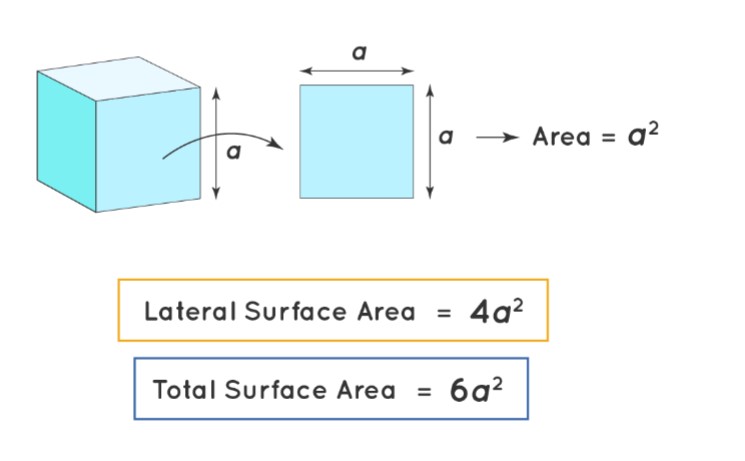Total Surface Area of Cube
The surface area of a cube refers to the combined area of all six of its square faces. To find this, we calculate the area of each of the two square bases and then add the areas of the four square lateral sides. A cube is a three-dimensional geometric figure composed entirely of square faces. Understanding its surface area is essential for tasks such as wrapping the cube or painting its surfaces effectively.
Also Check: Total Surface Area of Hemisphere
What is the Surface Area of a Cube?
The surface area of a cube equals the combined area of its bases and lateral surfaces. Each face of a cube is a square of identical dimensions. Therefore, the total surface area of a cube is calculated by multiplying the area of one face by six, as a cube has six faces. The measurement unit for surface area could be square centimeters, square inches, square feet, etc. There are two types of surface area that can be calculated for a cube: the area of its lateral surfaces alone, and the total surface area which includes all six faces.
- Area of lateral surface
- Surface area total

Total Surface Area (TSA) of a Cube
The Total Surface Area of a cube refers to the combined area of all six of its faces. This includes the area of each square face summed together to give the total external coverage of the cube.
Lateral Surface Area (LSA) of a Cube
The Lateral Surface Area of a cube specifically pertains to the total area of its side faces. To calculate the LSA, we sum the areas of these four rectangular faces. This measurement excludes the areas of the top and bottom faces, focusing solely on the sides that form the outer shell of the cube.
Surface Area of a Cube Formula
The surface area of a cube, which measures the total area that its six faces cover, depends on its edge length. Here's how we calculate both the total and lateral surface areas:
Total Surface Area of a Cube Formula
The total surface area of a cube is found by multiplying the square of its edge length by 6.
Formula: Total Surface Area = 6 × side2 square units
Lateral Surface Area of a Cube Formula
The lateral surface area of a cube considers only the area of its four side faces.
Formula: Lateral Surface Area = 4 × side2 square units
How to Find the Surface Area of a Cube?
The total surface area of a cube can be found by multiplying the square of its side length by 6. To calculate this, multiply the side length by itself (square it), and then multiply the result by 6
- Measure the Edge Length: Start by measuring the length of one side of the cube.
- Square the Edge Length: Calculate the square of this measured length.
- Calculate Surface Areas:
- For Total Surface Area: Multiply the squared side length by 6.
- For Lateral Surface Area: Multiply the squared side length by 4.
- Write Your Answer: Provide your solution in square units, which represents the total or lateral surface area of the cube.
Understanding these formulas and steps helps in accurately determining how much surface area a cube covers based on its dimensions.
Frequently Asked Questions
The Total Surface Area (TSA) of a cube is the sum of the areas of all six faces. The formula for the TSA of a cube is 6a^2, where 'a' is the length of one side. The Curved Surface Area (CSA) or Lateral Surface Area (LSA) of a cube is the combined area of the four side faces, which is 4a^2.
To find the surface area of a cube, you need to know the length of one side. Then, you can use the formula 6a^2 to calculate the Total Surface Area (TSA) of the cube, where 'a' is the side length. The Lateral Surface Area (LSA) is calculated as 4a^2.
The formula for the Total Surface Area (TSA) of a cube is 6a^2, where 'a' is the length of one side of the cube. This formula represents the sum of the areas of all six faces of the cube.
The Lateral Surface Area (LSA) or Curved Surface Area (CSA) of a cube is the combined area of the four side faces, excluding the top and bottom faces. The formula for the LSA of a cube is 4a^2, where 'a' is the length of one side.
The Total Surface Area (TSA) of a cube is the sum of the areas of all six faces of the cube. The formula for the TSA of a cube is 6a^2, where 'a' is the length of one side. This represents the total area that covers the outside of the cube.